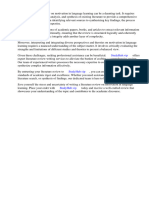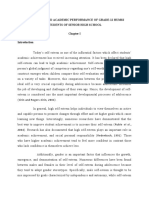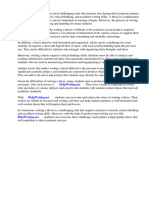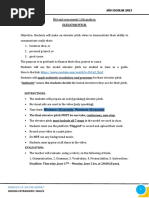Writing Sample Consultation Comments 2
Uploaded by
api-314534369Writing Sample Consultation Comments 2
Uploaded by
api-314534369Running head: Research in Educational Psychology
I chose self-regulation and its impact on achievement as a topic for my research assignment. I
am interested in this topics because over the years obtaining the highest level of achievement for
his or her students was every educators ambition. I always try to attend different workshops and
Commented [MP1]: Hello there! My name is Mike, and Ill be
looking at your paper today! I noticed you asked for some help
with idea generation, development, and organization, and Ill be
sure to give these areas my best attention! Lets get started!
Commented [MP2]: I think you can delete all of this: simply
starting with Because has a much more direct tone to the writing,
and eliminates unneeded phrasing.
follow new strategies in education which helped me in finding the best ways to achieve success
in my teaching. This topic focussed on the students self-regulation and its correlation with
learning. When the students have no internal motivation to learn and discipline themselves to
work in the class and pay attention, there will be very little that a teacher can do to achieve
learning or any kind of achievement. The topic and its findings support my strategies to reach my
students in a way that motivate them to want to learn more and to pay attention. I usually take the
first week of school in setting up the rules of the classroom which I will do my best to follow for
the rest of the year. Some people consider it a waste of time but for me, I see it a time used
constructively to establish a mutual responsibility of discipline between my students and myself.
This mutual responsibility will help the students self-regulate their behavior and have the desire
to learn.
1. Textbook Summary
In your own words, briefly summarize the topic as discussed in our textbook. To do this you will
paraphrase the textbook and use direct quotations (cite properly using APA format). Dont
simply copy directly from the text see how to avoid plagiarism here:
http://libguides.cmich.edu/content.php?mode=preview&pid=176679&sid=1749309
Learners have control over the way they acquire information and how they will use it to serve
their academic achievements or their future career goals. In other words, they engage in some
Commented [MP3]: I think this paper could benefit from one
more sentence here that summarizes what you will be talking
about.
Research in Educational Psychology
degree of self-regulated learning, self-regulated behavior, and more generally, self-regulation.
(Ormrod,J.(2012) p.111). to be able to reach the goals which they set for themselves.
Ormrod listed seven common values which demonstrated how learners will show self-regulation.
Self-regulating learners set a goal and try to do their best to achieve it. For example, if they
Commented [MP4]: This citation should be moved to the end
of this sentence. Also, it should look like this:
(Ormrod, 2012, p. 111).
Commented [MP5]: This is a good point, but maybe explain
what those seven common values are here? Be sure to cite the
values as a source if you use them.
dream of getting into a university and they need a scholarship, they will work hard to get As and
they might even pass an invitation to a party when they have an important assignment to finish.
Self-regulating learners keep themselves on track, they are keen to watch their performance and
how is it going which Ormrod called it self-monitering. They have enough confidence in
Commented [MP6]: This is spelled: monitoring
themselves to seek help if they need it in order to develop their skills further, as well as they try
to encourage themselves to keep working hard by reminding themselves that they are capable
and that success is a step ahead.
As learners move from childhood to adolescence, their self-regulation will mature. That due to
the maturation and to some degree because learners central-executive abilities depends on areas
in the front part of the brain, which continue to develop throughout childhood, adolescence, and
early adulthood. (Ormrod,J.(2012) p.114). The table on page 114 presents typical
advancements in self-regulation in the elementary and secondary school years.
(Ormrod,J.(2012) p.111). The table showed clearly the developmental trends at different grade
levels with clear examples on such trends as well as suggested strategies to deal with learners
from different levels and in different situations. Lastly, Ormrod talked about co-regulated
learning where the adult and children share responsibility for directing various aspects of the
learning process. (Ormrod,J.(2012) p.114).
Commented [MP7]: I had difficulty understanding this quote,
and how it relates to the rest of the paragraph. Perhaps add a
sentence after it and explain how it relates to the topic?
Research in Educational Psychology
In the book, Ormrod stated clearly that when children and adolescence are self-regulating, they
set more ambitious academic goals for themselves, learn more effectively, and achieve at higher
level in the classroom. (Ormrod,J.(2012) p.114).
Research Article 1 Summary:
What questions related to your topics did the article investigate?
Although the study did not give many strategies promoting self-discipline and selfregulation in the classroom, it was useful in giving an insight into an interesting aspect of
achievement by comparing SD and SR with the achievements level of the students in the study.
In addition, the study sought to answer several methodological questions dealing with the
assessment of SD and SR.(p.146) (Zimmerman & Kitsantas, 2014.) The study offers
educators an empirical basis for identifying poorly regulated students and diagnosing
Commented [MP8]: I suggest making this citation, as well as all
the others, match the style of the example I created in my previous
comment about the subject.
dysfunctions their learning and motivation processes. p.154) (Zimmerman & Kitsantas, 2014.)
Identifying poorly regulated students is the first step toward helping those students to take their
learning a step in the right direction toward self-efficacy beliefs and goal orientations that
precede attempts to learn . (p.145) (Zimmerman & Kitsantas, 2014.)
Methodology:
Commented [MP9]: This paragraph is very unbalanced with
quoted material. Of the four sentences, three of them have direct
quotation from another source. This is too much, and should be
reduced to only one. My advice would be to take out two of the
quotes, and replace them with paraphrases.
The research used a multi-source, multi-measure research design involving 507 high
school students and their teachers.P.145 (Zimmerman & Kitsantas,2014).The study tests the
hypothesis that self-regulation learning measures will predict students academic achievement
better than self-discipline performance measures.P.146. (Zimmerman & Kitsantas,2014)
Conclusions:
Commented [MP10]: As mentioned in the previous comment,
this paragraph also needs more original writing and less quoted
material.
Research in Educational Psychology
The researchers learn from this study that the self-regulation composite was more
predictive of students grade point average and performance on a stat- wide achievement test
than the self-discipline composite. P.145. (Zimmerman & Kitsantas,2014) As well as The
structural Equation Modeling analyses indicated that the SR latent factor predicted both
measures of students achievement significantly, but the SD factor did not predict either
achievement measure significantly. When the SD and SR effects on students achievement
compared, the SR results surpassed the SD. The result of the study gave an indication that the
level of achievement will be higher when the learners effort is self-initiated, strategically
guided, and self-sustained. P.145. (Zimmerman & Kitsantas,2014)
The study helped answer the researcher question about students SD or SR prediction of
academic achievement. These results suggested a path for integrating two relatively separate
streams in self-regulation research in the basis of a well-established distinction between learning
and performance processes. P.145. (Zimmerman & Kitsantas,2014)
Research Article 2 Summary:
What questions related to your topics did the article investigate?
The article tested the relationships between academic self-efficacy, individual interest, grade
goals, self-regulation, and achievement of Korean middle school students (N = 500) in four
different subject areas. P.86. (Woogul Lee, Myung-Jin Lee, Mimi Bong, 2014). The study also
examined whether individual interest, as an affective motivational variable, could predict
Commented [MP11]: This quote is far too long to include in a
single paragraph. Even still, it is not the only quote in the
paragraph, which demonstrates a larger issue. As I look throughout
the rest of this paper, I have noticed that a large portion of the text
comes from other authors. While it is good that the citations are
included, I still cannot comment on writing that is not yours. To
that end, I will read through the rest of this paper, and list some
general thoughts about the ideas at the end, but I cannot make any
further structural comments while so much of the paper remains
written by other authors.
Research in Educational Psychology
academic self-regulation and achievement, above and beyond what academic self-efficacy
predicted P.86. (Woogul Lee, Myung-Jin Lee, Mimi Bong, 2014)
Application:
The first article gave me a strong evidence on the importance of self-regulation. It is very
essential for me as a teacher to keep in mind the different strategies that promote self-regulation
among my students.
Methodology:
The research studied five hundred middle school students from two suburban cities near
Seoul, Korea. The survey tool place once each semester within the academic year. P.89. (Woogul
Lee, Myung-Jin Lee, Mimi Bong, 2014)
Conclusions:
The researchers believed that this study give at least three important contributions to the
existing literature on academic self-regulation.P.98. (Woogul Lee, Myung-Jin Lee, Mimi Bong,
2014) They believed that their research demonstrates that individual interest function as a
unique facilitator of academic self-regulation and subsequent academic achievement. P.98.
(Woogul Lee, Myung-Jin Lee, Mimi Bong, 2014) Second, the present results suggest the strong
possibility that the pathways associated with interest-based self-regulation and efficacy-based
self-regulation are distinct from each other. P.98. (Woogul Lee, Myung-Jin Lee, Mimi Bong,
2014) Third, the study revealed significant gender differences in the relative importance of each
construct in girls and boys academic self-regulation and achievement. P.98. (Woogul Lee,
Myung-Jin Lee, Mimi Bong, 2014) and this finding opens up many interesting possibilities in
Research in Educational Psychology
future studies of academic self-regulation. P.98. (Woogul Lee, Myung-Jin Lee, Mimi Bong,
2014)
Analysis:
Connection and differences: Did the article differ in the way they discussed/defined the topic.
Commented [MP12]: The below section has more original
writing, and so I will include structural comments regarding it.
The articles differ in the way they researched and tested different predictors of
achievement. Although, both articles focussed mainly on self-regulation as a major predictor for
academic achievement, they differ in their approach, the predictors they focussed on, and the
group of students the researched and their method.
The first article compared self-discipline and self-regulation as a predictor for achievement. On
the other hand the second article tested interest and self-efficacy as predictors of academic selfregulation and achievement.
The first article focussed on the different affect that SR and Sd have on the results of GPA and
state wide testing for the high school students in the study. The second article used a survey to
test students by comparing the relationship between academic self-efficacy, individual interest,
grade goals, self-regulation, and achievement.
The two articles studied different group of students. The first article studied 507 high school
students and their teachers using three of the five scales that Duckworth & Seligman (2005,
2006) used in their studies. P.98. (Woogul Lee, Myung-Jin Lee, Mimi Bong, 2014) The second
article surveyed 500 Korean middle school students in four different subject areas.
As we can see, the two articles studied achievement from different angels which clearly
demonstrate how academic education is a vast subject of study and researchers would be
studying it for years to come.
Commented [MP13]: These paragraphs contain well-written
analyses of the previous material. However, I would recommend
group information about each article together. First, have a
paragraph all about the first article. Then, another about the
second. This will organize the information more concurrently, and
make it easier to read and enjoy.
Research in Educational Psychology
From studying the two articles and the book, I learned that self-regulation played a major role in
predicting academic achievement. There are many factors that affect the learners self-regulation
such as self-discipline, self-efficacy, and interest which ultimately will affect his or her academic
achievement. In order to achieve the best academic level, educators have to implement and use
many strategies to promote self-regulation. Educators had to keep in mind that learners
motivation plays a very important role in the achievement and identifying poorly regulated
students will help in achieving the goals. The study showed the effect of interest, gender, selfdiscipline, and when students are self-regulated they will achieve more.
Commented [MP14]: Your writing is very strong! Your English
is impressive, and your ideas are solid in their structure. However,
as I stated before, you rely much too heavily on the words of others
right now, and that decreases this papers strength.
As far as the flow of ideas, I found there were times where ideas
became slightly jumbled. I would suggest making an outline of
topics to hit in a precise order about one study, and then use that
same list for the second study to create continuity.
All in all, this paper is well on its way, but it can only become
stronger with more original material.
Should you have any questions, feel free to resubmit! Good luck,
and happy writing!
-Mike
You might also like
- Where The Forest Meets The Sea Sample Lesson Plan100% (2)Where The Forest Meets The Sea Sample Lesson Plan29 pages
- The Life Skills Handbook: Section THREE Download 5 of 8 Activity Sessions 24-32No ratings yetThe Life Skills Handbook: Section THREE Download 5 of 8 Activity Sessions 24-3226 pages
- Graduate SLUWE Samples 1+2 With APA GuideNo ratings yetGraduate SLUWE Samples 1+2 With APA Guide8 pages
- Reading 9 5 Keys To Motivating Students PDFNo ratings yetReading 9 5 Keys To Motivating Students PDF2 pages
- Book Summary Learner Centered Teaching by Maryellen Weimer100% (2)Book Summary Learner Centered Teaching by Maryellen Weimer9 pages
- Literature Review On Motivation in Language LearningNo ratings yetLiterature Review On Motivation in Language Learning7 pages
- Educ 5312-Research Paper - Samir AhmadovNo ratings yetEduc 5312-Research Paper - Samir Ahmadov4 pages
- Student Example - MLA Annotated BibliographyNo ratings yetStudent Example - MLA Annotated Bibliography4 pages
- Effect of Self-Assessment On Academic Performance of Secondary School Students in Rivers State of NigeriaNo ratings yetEffect of Self-Assessment On Academic Performance of Secondary School Students in Rivers State of Nigeria8 pages
- Best Ever Way of Writing A Teaching Philosophy in The WorldNo ratings yetBest Ever Way of Writing A Teaching Philosophy in The World3 pages
- Final Term Project B: Faculty: Sir Dr. Omar JavedNo ratings yetFinal Term Project B: Faculty: Sir Dr. Omar Javed22 pages
- Literature As Data Table - Level 3 Rev Fall 2022No ratings yetLiterature As Data Table - Level 3 Rev Fall 20227 pages
- Fass 352 Literature Review Ranim AnnousNo ratings yetFass 352 Literature Review Ranim Annous16 pages
- The Use of Photos in Making Reflective Essays (UPDATED)No ratings yetThe Use of Photos in Making Reflective Essays (UPDATED)17 pages
- Improvements of Students' Motivation in Mapeh Classes: An Action ResearchNo ratings yetImprovements of Students' Motivation in Mapeh Classes: An Action Research17 pages
- Student Motivation: An Annotated Bibliography by Angela Shaw June, 2014 ED7999 Master's ProjectNo ratings yetStudent Motivation: An Annotated Bibliography by Angela Shaw June, 2014 ED7999 Master's Project19 pages
- Chapter Five Data Collection and Analysis 5.1 Framing The ResultsNo ratings yetChapter Five Data Collection and Analysis 5.1 Framing The Results48 pages
- Teaching Students About Science From The Teaching Models We Use: Lessons Learned From A 4 Grade Science UnitNo ratings yetTeaching Students About Science From The Teaching Models We Use: Lessons Learned From A 4 Grade Science Unit6 pages
- Most Likely To Harbor This Assumption Are Practitioners Who Have Been Heavily Immersed inNo ratings yetMost Likely To Harbor This Assumption Are Practitioners Who Have Been Heavily Immersed in6 pages
- Monitoring Student Performance With Self-Evaluation Checklists: An Ongoing Case StudyNo ratings yetMonitoring Student Performance With Self-Evaluation Checklists: An Ongoing Case Study21 pages
- Course: Psychological Perspectives of Sport Lesson: Motivation in SportNo ratings yetCourse: Psychological Perspectives of Sport Lesson: Motivation in Sport6 pages
- Using Formative Assessment to Improve Student Outcomes in the ClassroomFrom EverandUsing Formative Assessment to Improve Student Outcomes in the ClassroomNo ratings yet
- Validation of The Five-Factor Model of Personality Across Instruments and ObserversNo ratings yetValidation of The Five-Factor Model of Personality Across Instruments and Observers10 pages
- Attitude of The Students Towards Academic Performance2.100% (3)Attitude of The Students Towards Academic Performance2.22 pages
- Study of How The Psychological Effects of Social Media Affect The Grade 11 STEM Students in Sablayan Comprehensive High SchoolNo ratings yetStudy of How The Psychological Effects of Social Media Affect The Grade 11 STEM Students in Sablayan Comprehensive High School23 pages
- Effectiveness of Metacognition-Based Reading Enrichment ProgramNo ratings yetEffectiveness of Metacognition-Based Reading Enrichment Program10 pages
- Writting Skill_7e2c8d5f-3fba-4b64-9b60-738f63dfb1b5No ratings yetWritting Skill_7e2c8d5f-3fba-4b64-9b60-738f63dfb1b553 pages
- Glencoe Understanding Psychology 1st Edition by Richard Kasschau 0078203384 978-0078203381 - Instantly access the full ebook content in just a few seconds100% (5)Glencoe Understanding Psychology 1st Edition by Richard Kasschau 0078203384 978-0078203381 - Instantly access the full ebook content in just a few seconds87 pages
- Business Communication MBA 102: AssignmentNo ratings yetBusiness Communication MBA 102: Assignment12 pages
- The Life Skills Handbook: Section THREE Download 5 of 8 Activity Sessions 24-32The Life Skills Handbook: Section THREE Download 5 of 8 Activity Sessions 24-32
- Book Summary Learner Centered Teaching by Maryellen WeimerBook Summary Learner Centered Teaching by Maryellen Weimer
- Literature Review On Motivation in Language LearningLiterature Review On Motivation in Language Learning
- Effect of Self-Assessment On Academic Performance of Secondary School Students in Rivers State of NigeriaEffect of Self-Assessment On Academic Performance of Secondary School Students in Rivers State of Nigeria
- Best Ever Way of Writing A Teaching Philosophy in The WorldBest Ever Way of Writing A Teaching Philosophy in The World
- The Use of Photos in Making Reflective Essays (UPDATED)The Use of Photos in Making Reflective Essays (UPDATED)
- Improvements of Students' Motivation in Mapeh Classes: An Action ResearchImprovements of Students' Motivation in Mapeh Classes: An Action Research
- Student Motivation: An Annotated Bibliography by Angela Shaw June, 2014 ED7999 Master's ProjectStudent Motivation: An Annotated Bibliography by Angela Shaw June, 2014 ED7999 Master's Project
- Chapter Five Data Collection and Analysis 5.1 Framing The ResultsChapter Five Data Collection and Analysis 5.1 Framing The Results
- Teaching Students About Science From The Teaching Models We Use: Lessons Learned From A 4 Grade Science UnitTeaching Students About Science From The Teaching Models We Use: Lessons Learned From A 4 Grade Science Unit
- Most Likely To Harbor This Assumption Are Practitioners Who Have Been Heavily Immersed inMost Likely To Harbor This Assumption Are Practitioners Who Have Been Heavily Immersed in
- Monitoring Student Performance With Self-Evaluation Checklists: An Ongoing Case StudyMonitoring Student Performance With Self-Evaluation Checklists: An Ongoing Case Study
- Course: Psychological Perspectives of Sport Lesson: Motivation in SportCourse: Psychological Perspectives of Sport Lesson: Motivation in Sport
- Using Formative Assessment to Improve Student Outcomes in the ClassroomFrom EverandUsing Formative Assessment to Improve Student Outcomes in the Classroom
- Validation of The Five-Factor Model of Personality Across Instruments and ObserversValidation of The Five-Factor Model of Personality Across Instruments and Observers
- Attitude of The Students Towards Academic Performance2.Attitude of The Students Towards Academic Performance2.
- Study of How The Psychological Effects of Social Media Affect The Grade 11 STEM Students in Sablayan Comprehensive High SchoolStudy of How The Psychological Effects of Social Media Affect The Grade 11 STEM Students in Sablayan Comprehensive High School
- Effectiveness of Metacognition-Based Reading Enrichment ProgramEffectiveness of Metacognition-Based Reading Enrichment Program
- Writting Skill_7e2c8d5f-3fba-4b64-9b60-738f63dfb1b5Writting Skill_7e2c8d5f-3fba-4b64-9b60-738f63dfb1b5
- Glencoe Understanding Psychology 1st Edition by Richard Kasschau 0078203384 978-0078203381 - Instantly access the full ebook content in just a few secondsGlencoe Understanding Psychology 1st Edition by Richard Kasschau 0078203384 978-0078203381 - Instantly access the full ebook content in just a few seconds

























































































